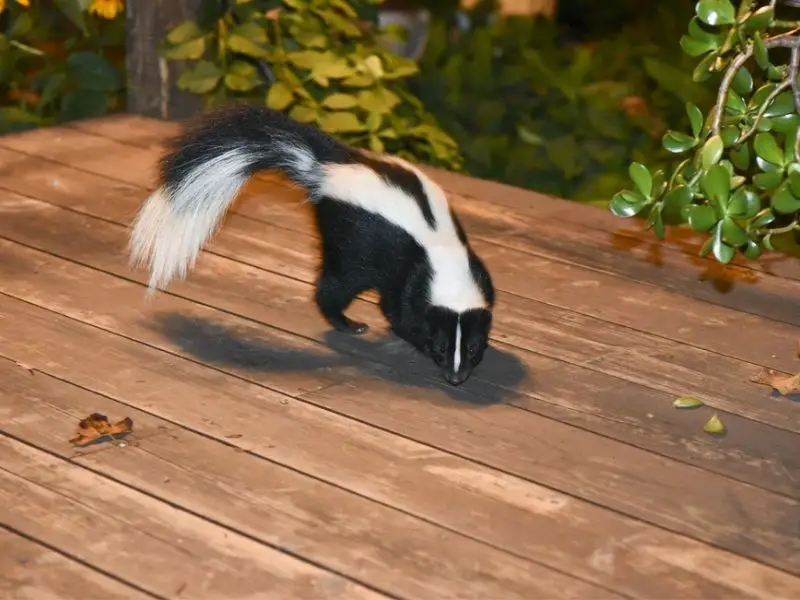How Do You Get Rid of Skunks under Deck
Skunks are also known as polecats, are known to inhabit the underside of decks and porches. However, their smelly anal spray and potential for structural damage mean that you can’t afford to let them stay within your property. So, how do I get rid of skunk under the deck?
To effectively get rid of skunks under your deck, you need to starve them by cutting off their food sources. In addition, you can spray skunk repellents, and set up skunk traps under the deck, or just hire a skunk expert in your area.
Do skunks hide under decks?
Whenever skunks invade your home, they’ll most likely seek refuge under the deck where it’s dark and food is readily available. It’s hard for humans and other animals to spot them in such a heavily-shaded area. Meanwhile, if you have trees growing in your yard, some of the falling fruits, berries, and nuts end up under your deck; making it an easy source of food for skunks.

Additionally, most homeowners barely consider the underside of the porch when undertaking yard maintenance. As such, grass typically grows tall in this area, consequently attracting insects. Since skunks feed on insects as well, they’ll readily make a home out of such insect-infested decks.
Some homeowners keep trash bins next to the deck area, or underneath it. Since skunks can live off of garbage alone, they’ll inhabit the base of your deck and come out at night to feed on the garbage.
Finally, female skunks prefer to have and rear their babies on the underside of decks since they find it quiet, dry, and protective. Wildlife protection agencies usually advise homeowners against getting rid of adult female skunks if they’ve already given birth to a litter of babies.
Signs there’s a skunk under your deck
You can tell that there’s a skunk living under your deck from the strong, unpleasant odor coming from the deck area, the presence of shallow burrows on your yard, and the presence of cat-like footprints. You may also have skunks under your porch if some of the grass sods on your yard are rolled-back, or if your dog constantly barks near the deck area.
Unpleasant Smell
If there’s a strong, bad smell coming from under your deck, you most likely have a skunk living there. The smell comes from the liquid that they spray from their anal glands whenever they feel threatened. Thus, if you have a pet cat or dog and it has a skunk-like smell, it could have come across a skunk under your deck.
Shallow Yard Holes
Skunks are excellent burrowers. They’ll dig around, shallow holes in your yard as they hunt for soil-dwelling insects to feed on.
Footprints
If you have cat-like footprints in and around your deck area, they could be from a skunk living under the deck. The only difference between a skunk and a cat’s footprint is that the former has five toes, with a slightly larger foot.
Rolled-back Grass Sods
Despite being excellent diggers, skunks prefer to take the easier route. Thus, if you have loosely-laid sod on your yard, they’ll prefer to roll it back than dig through it. If you notice rolled-back grass sod on your yard, it’s probable that skunks are within your compound, most likely under the deck.
Dog Barks
If your pet dog is barking every time it passes by the deck area but you can’t see anything, don’t rule out the possibility of a skunk being under the deck.
How to Get Rid of Skunks under the Deck
If you can’t withstand skunks and their unpleasant odor, you can get rid of them by cutting off their sources of food, installing a one-way door, and installing yard lights. Spraying skunk repellents and setting up skunk traps are also effective ways of controlling this invasive mammal.

Here is how to get rid of skunks under the deck:
1. Remove Natural Food Sources
If you have trees in your yard from which fruits, nuts, and berries regularly fall off; ensure to rake your yard often. This will get rid of the natural food source that’s attracting these smelly burrowers. Meanwhile, you should also mow your yard to get rid of tall grass and discourage skunk inhabitation.
2. Safeguard your Waste
To prevent skunks from feeding on the garbage within your waste bins, keep them properly sealed. Locking waste cans do a better job at starving scavenging animals like skunks, compared to regular trash bins. Meanwhile, if you have a compost bin, make sure you enclose it, as skunks love to feed on decaying fruit and vegetable peelings.
Note: Since the smell of garbage attracts skunks, you can store the trash bins inside your garage overnight. Skunks will be forced to move out of your property if they can’t find any food sources.
3. Install a One-way Door
Installing a ‘one-way’ door underneath your deck will allow a skunk that’s inhabiting the space to leave but not come back in. However, you should only use this strategy if the skunk doesn’t have babies, as it’s inhumane to leave them trapped underneath the porch without a mother.
4. Install Yard Lights
As earlier mentioned, skunks love dark places where they can hide out without being noticed. Thus, by installing yard floodlights that light up your deck section as well, skunks may find the habitat unappealing and move out to a new place. Alternatively, you can install lighting fixtures directly underneath the deck.
5. Apply Skunk Repellents
You can also spray chemical repellents around your porch and yard area to deter skunks. However, since they wane off with time, they have to be reapplied often. If you prefer natural alternatives that won’t cause environmental degradation you can opt for fox urine, dog urine, pepper spray, orange peels, and lemon peels.
Note: Ammonia is also an effective natural skunk repellent. Simply soak old pieces of cloth in an ammonia solution and place them underneath your deck.
6. Set up a Spring-Loaded Skunk Trap
If your area wildlife laws permit it, you may also set up a spring-loaded skunk trap near your deck to trap any skunk living underneath the structure. Raccoon traps and feral cat traps will also work just fine.
Place bait foods such as sardines or peanut butter inside the trap to attract the skunk. After trapping the animal, release it within one mile of your home, as skunks are unlikely to survive if relocated too far away from their original habitat.
Caution: When handling trapped skunks, take care to avoid being a victim of its smelly spray. Also, if you’re unsure of how to humanely handle and release skunks, contact your local wildlife department for help.
7. Set up a Garbage Can Trap
A DIY, budget-friendly, and homemade alternative to a spring-loaded trap is a large garbage can trap.
- To set it up, place cat food or sardines as bait inside a metallic trash can. Then, position the can against the wall so that your weasel invader doesn’t knock it over.
Note: Use a large and deep can that the skunk can’t climb out of, preferably, a 30-gallon container.
- Next, position a long wood plank diagonally from the top of the open garbage bin to the ground, forming a ramp that the skunk can easily use to climb to the can. Once the skunk falls into the can, it’ll be trapped due to the depth and emptiness of the bin.
- Finally, release the mammal in a humane manner. When handling skunks, avoid coming too close to them if you don’t want them to unleash their smelly anal spray on you. The best option would be to contact your area wildlife center for help.
8. Call in the Pros
If money isn’t an issue, consider calling in professional help. A professional trapper will safely trap skunks from underneath your deck and humanely release them elsewhere. They also know how to handle female skunks that have recently given birth and will get rid of both the mother and the babies without separating them.
What damage can skunks cause under the house?
Skunks can bring damage to your home, they can destroy electrical wiring, plumbing leakages, vent screen, and foundation damages to your house.
Here are some of the damages that can be caused by skunks under the decks:
Foundation Damage
Skunks can do worse to your home than just making the deck area smelly. For starters, these burrowing mammals can cause extensive structural damage to your home’s foundation. When looking to gain access underneath your home, they’ll burrow through cracks and weak spots in your foundation and crawlspace, thus compromising your home’s structural integrity.
Damaged Electrical Wiring
Skunks also pose a significant risk of electric fire, as they can eat through electrical wires when burrowing through your foundation. What’s more, you may have to deal with unprecedented power outages if skunks cut the electrical wires.
Plumbing Leakages
If you also have plumbing pipes running through your home’s foundation or crawlspace, a burrowing skunk may cause the pipes to burst open. Plumbing leakages to your home’s foundation will cause moisture buildup, which will consequently cause structural damage and mold infestation.
Vent Screen Damage
If you have ground-mounted vent screens, skunks may tear them open with their sharp, strong claws to gain access to your home’s basement or crawlspace. This presents an additional problem, as other critters may also use the openings to gain access to your home.



